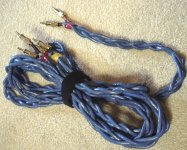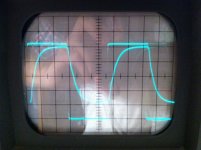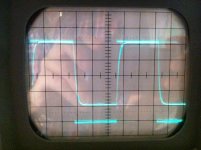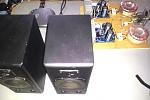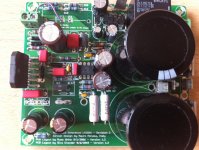I'm finally building the My-Ref c kit I ordered a few years ago and wondered whether anyone knew if the amplifier has problems with a high Capacitive load from the speaker?
The reason I ask is because I've been reading the articles on speaker cables on Rod Elliot's site, and am considering constructing a braided Cat 5 speaker cable in order to reduce the inductance and resistance. However the downside is high capacitence, which is fine if the My-Ref C can handle this, but is a no-go if it can't.
Can anyone shed any light onto this?
Thanks
The reason I ask is because I've been reading the articles on speaker cables on Rod Elliot's site, and am considering constructing a braided Cat 5 speaker cable in order to reduce the inductance and resistance. However the downside is high capacitence, which is fine if the My-Ref C can handle this, but is a no-go if it can't.
Can anyone shed any light onto this?
Thanks
I have had excellent results with a recent build of this DIY recipe combined with the MyRef - Fremem Edition. Should be the same with V1.2 and V1.3.
The photo is what I used for almost a year with no amp stability problems at all.
The photo is what I used for almost a year with no amp stability problems at all.
Attachments
You'r welcome. A little tip - don't be stingy with the initial length. I started with 14' cuts and ended up with a cable ~ 10' after the third braid. There is a dramatic difference between using a tight and a loose braid. Starting in the middle of each course and braiding to the ends is a lifesaver. Cat6 reportedly has a little higher grade copper than Cat5.
My Impression of these is an improvement in both stage reality and clarity/separation. Bass is controlled and abundant. I have never owned any high dollar boutique cables but I have heard a $600 set at a friends house - with the FE amps. I'm keeping my cash in my pocket
Good Luck!
My Impression of these is an improvement in both stage reality and clarity/separation. Bass is controlled and abundant. I have never owned any high dollar boutique cables but I have heard a $600 set at a friends house - with the FE amps. I'm keeping my cash in my pocket
Good Luck!
Last edited:
I have used Aplha Core cables with good results.
If you plan to braid your own cables, the best results seems to be when the conductors intersect in a perpendicular way, Speakerbuilder published this a long time ago. Best to use twice the length of what you actually need to begin with.
If you plan to braid your own cables, the best results seems to be when the conductors intersect in a perpendicular way, Speakerbuilder published this a long time ago. Best to use twice the length of what you actually need to begin with.
braiding increases inductance, not lowers it.
Close coupled pair is the closest for least inductance and maximum capacitance, for a pair.
Star quad is higher in capacitance and that probably means even lower inductance, but I'm not sure since I have not seen a reference.
The more cores in the bundle, the higher the capacitance , if the flow and return cores are still adjacent.
If all the flows and all the returns were each bundled and then the two sets were close coupled, the capacitance would fall and the inductance would rise.
Braiding has a similar effect, it introduces air spaces between the flow and return cores. That removes the "close coupled" geometry and results in lower capacitance.
Close coupled pair is the closest for least inductance and maximum capacitance, for a pair.
Star quad is higher in capacitance and that probably means even lower inductance, but I'm not sure since I have not seen a reference.
The more cores in the bundle, the higher the capacitance , if the flow and return cores are still adjacent.
If all the flows and all the returns were each bundled and then the two sets were close coupled, the capacitance would fall and the inductance would rise.
Braiding has a similar effect, it introduces air spaces between the flow and return cores. That removes the "close coupled" geometry and results in lower capacitance.
Square wave response question
Hi,
I've just finished to solder two monoblocks (Rev C PCB rev1.3 I've bought almost two years ago from linuxguru...).
Before plugin to the speakers I've done some basic measurements. DC Offset at output looks ok around 2mV and 5mV, but square wave response is strange above 3Khz, it is very "damped" compared to what I'm used to see on a classic gainclone. Here are two pics of a 5Khz square wave response, one from a MyRef monoblock and one from a LM3875 minimalist GC,.
Is that the normal MyRefRevC behavior ?
Is it safe to plug the "real" speakers ?
Thank you for your help,
Hi,
I've just finished to solder two monoblocks (Rev C PCB rev1.3 I've bought almost two years ago from linuxguru...).
Before plugin to the speakers I've done some basic measurements. DC Offset at output looks ok around 2mV and 5mV, but square wave response is strange above 3Khz, it is very "damped" compared to what I'm used to see on a classic gainclone. Here are two pics of a 5Khz square wave response, one from a MyRef monoblock and one from a LM3875 minimalist GC,.
Is that the normal MyRefRevC behavior ?
Is it safe to plug the "real" speakers ?
Thank you for your help,
Attachments
I believe best practice is to use inexpensive/test/junk speakers for initial testing. They don't even have to be in an enclosure at this point. I let the system run for about an hour before attaching main/real speakers.
Attachments
Last edited:
Thanks bcmbob,
I did that already and it sounds OK with a martyr car speaker.
But as I was expecting a much cleaner square wave response in medium and hi range I want to be sure that I didn't miss something in my build (here is a pic of a board).
What does square wave responses look like on your working MyRef RevC amps guys ? I've searched various Myref related threads in this forum but didn't find any...
I did that already and it sounds OK with a martyr car speaker.
But as I was expecting a much cleaner square wave response in medium and hi range I want to be sure that I didn't miss something in my build (here is a pic of a board).
What does square wave responses look like on your working MyRef RevC amps guys ? I've searched various Myref related threads in this forum but didn't find any...
Attachments
No, tested board is DC coupled, but my square wave generator has a cap on its output and send no DC. I don't think amp's response in 5Khz region will change by adding another DC blocking input cap.Did you scope with something in C13?
Hi Bismuth,
What is the output impedance of your generator? Do you have an input potentiometer in place? What value is it / where is the viper placed?
You have 330 pF input capacitance on Myref. (Did You control?) The Tau of the input lowpass filter is ~1usec, ~130kHz. IF your generator has not more than 50 ohm output impedance!
On your picture the Tau (if that is really a 5kHz square wave, 40usec/div)) is something around 20/30usec, a lot higher than the design value.
Other possibility: Did You control the compensation cap values?
Ciao, George
What is the output impedance of your generator? Do you have an input potentiometer in place? What value is it / where is the viper placed?
You have 330 pF input capacitance on Myref. (Did You control?) The Tau of the input lowpass filter is ~1usec, ~130kHz. IF your generator has not more than 50 ohm output impedance!
On your picture the Tau (if that is really a 5kHz square wave, 40usec/div)) is something around 20/30usec, a lot higher than the design value.
Other possibility: Did You control the compensation cap values?
Ciao, George
Thank you very much George and Siva, I've checked the on board RC filter, it is 3K3 and 220pF.
I do not know the output impedance of the generator, I've to check that.
I guess I didn't do my homework correctly before plugin the generator directly without a pot, I now just tried to put a potential divider (3K/3K) to adapt impedance to see what happened. I do not know what I did wrong but I fried one my monoblock ! I think the LM318 is dead, no more relay clicking on startup and huge DC on LM318 output (pin 6)....
I do not know the output impedance of the generator, I've to check that.
I guess I didn't do my homework correctly before plugin the generator directly without a pot, I now just tried to put a potential divider (3K/3K) to adapt impedance to see what happened. I do not know what I did wrong but I fried one my monoblock ! I think the LM318 is dead, no more relay clicking on startup and huge DC on LM318 output (pin 6)....
what does the phase tracking look like on myref?
a local techie was telling me the other day the reason why accuphase was such an endearing listen was because of accurate phase (i already knew this, though). and I wanted to tell him that myref probably sounds better but didn't have any facts to back up my claim.
so is myref's phase response accurate?
a local techie was telling me the other day the reason why accuphase was such an endearing listen was because of accurate phase (i already knew this, though). and I wanted to tell him that myref probably sounds better but didn't have any facts to back up my claim.
so is myref's phase response accurate?
I do recall I have posted some measurements a while back. Phase lag in the speaker is much more than the amplifier. If the amplifier is designed to specifically improve the phase response of the total system, that is where the improvement can be outstanding. But the MyRef is not a pure voltage source amplifier, so it needs to be considered in a different way.
- Home
- Amplifiers
- Chip Amps
- My "audiophile" LM3886 approach
